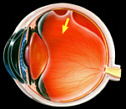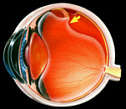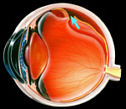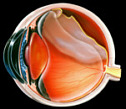|
The Sunetra Eye Centre also offers diagnosis and treatment
of many other types of retinal disorders including retinal
tears and retinal detachments. However, in some cases, the
Sunetra Eye Centre may refer patients to other specialists
in the region for a particular retinal disorder.

A retinal
detachment is a serious eye problem which effects one if every
10,000 people. Retinal detachment occurs when the retina becomes
separated from the back wall of the eye. When the retina becomes
detached, its blood supply is reduced and its ability to process
light rays is impaired. If total detachment occurs, the retina
becomes useless, as it can no longer transmit information
to the brain, and the eye becomes blind.
What Causes Retinal Detachment
/ Tears
As part
of the normal aging process, the clear fluid which fills the
inner cavity of the eye begins to shrink and pull away from
the retina (see the diagram below
-yellow arrows). Most of the shrinking causes no
damage to the eye. However, sometimes the vitreous remains
attached to the retina and then the shrinking of the vitreous
causes the retina to tear.
Left untreated,
retinal tears can lead to retinal detachments (see
blue arrow in diagram above). Once a retinal tear
is present, fluid from the vitreous may seep through the tear
into the space between the retina and the wall of the eye.
The fluid causes the retina to separate from the back of the
eye or detach (see last diagram above).
The part of the retina which becomes detached will not function
properly, resulting in vision loss.
What are the Symptoms
of Retinal Detachments / Tears
Retinal
tears may develop without any noticeable symptoms. In other
cases, the vitreous gel pulling away from the retina may cause
the patient to see flashes of light. Floaters, whish appear
as black spots or lines in the field of vision, may result
from bleeding of torn retinal vessels or the formation of
small clumps of vitreous matter.
Once retinal
detachment occurs, the patient may notice a wavy or watery
quality in their vision. If detachment occurs in the peripheral
retina, a curtain or shadow may appear across the field of
vision. If the area of detachment is in the macula, central
vision will be distorted and reduced. The patient will be
unable to read or see in fine detail. Occasionally, detachment
occurs suddenly and is accompanied by a total loss of vision.
Treatment

Many retinal
tears can be treated with lasers or with a freezing probe
(cryopexy) and can be done on an outpatient basis in an ambulatory
surgery center like the Sunetra Eye Centre. Once a retina
becomes detached, it must be repaired surgically, usually
in a hospital setting.
Prevention is the
Best Medicine
Retinal
tears and detachments are serious problems which require immediate
treatment. Persons who are severely nearsighted or have a
family history of retinal detachment should have regular eye
examinations to detect any changes in the vitreous or retina.
Persons who have suffered a serious eye injury should also
be examined for retinal damage. With early diagnosis, retinal
tears can be treated before retinal detachment and loss of
vision occurs.
If you
are experiencing the symptoms of a retinal tear or detachment
or another vision problem, you should contact an eye physician
immediately.
|
|






